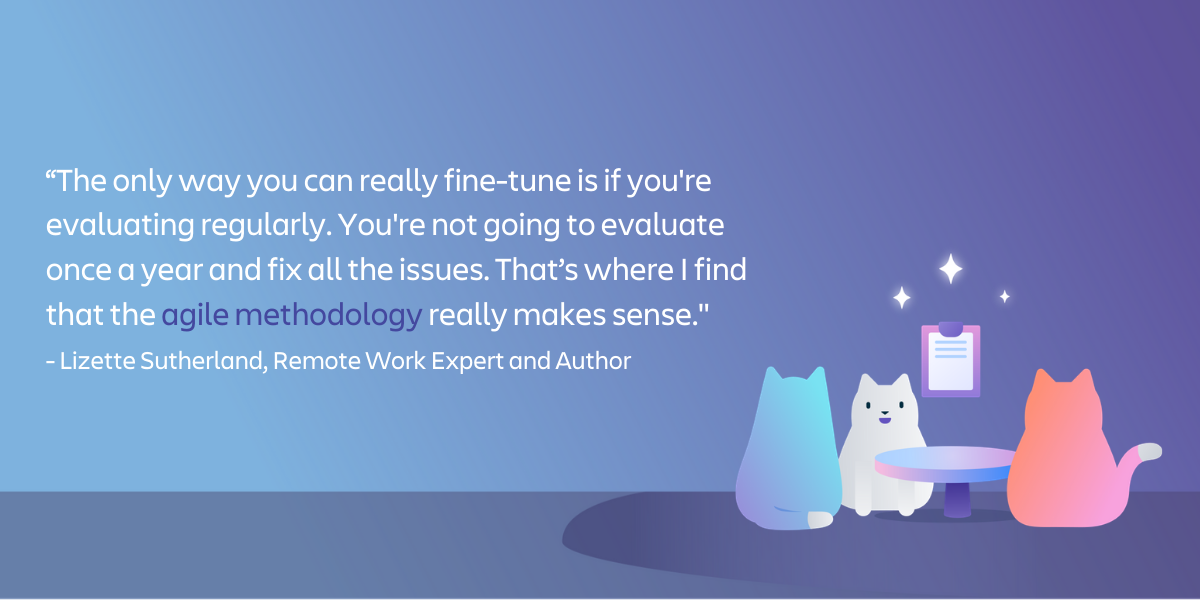Many companies are leaning into the notion that working remotely doesn’t have to mean a sacrifice in work quality. What it does mean, however, is that leaders need to set their remote teams up for success.
As a leader, you want to create a remote environment that’s collaborative, efficient, and empowers team members to do their best work. And while there are plenty of different ways to accomplish that goal, there’s one framework that is particularly helpful for remote teams—and that’s the agile framework. This framework helps teams deliver work in small but consumable increments while valuing adaptability and flexibility to their processes and plans. .
Agile methodology has been a go-to in the software world for years. But as more companies go remote, agile is starting to gain serious traction in industries across the board.
Curious about the agile methodology and how it can benefit your remote team?
We asked Lisette Sutherland, remote work expert and co-author of Work Together Anywhere: A Handbook on Working Remotely—Successfully—for Individuals, Teams, and Managers for her insights on how remote teams can adopt agile practices to work more collaboratively and efficiently.
What Is Agile Methodology?
First things first—before we jump into how to use agile practices to help your remote team thrive, let’s quickly cover the basics of agile methodology.
Instead of focusing on big picture goals or taking a more long-term approach to getting things done, agile practices break down projects into short iterations known as “sprints.” Sprints typically last anywhere from a week to month, and teams have clear objectives of what they need to be working on, what needs to get accomplished, and when.
The facilitator or leader of the agile team is known as the scrum master. Every morning, the scrum master hosts a quick check-in (known as a “stand up”) where the entire team shares status updates. At the end of the sprint, the team gets together for a more in-depth meeting—known as a retrospective, or “retro”—to review the sprint and identify opportunities for improvement moving forward.
Then, you choose the objectives and tasks to focus on for the next sprint, and rinse and repeat.
The agile framework is effective for a variety of team structures. But it’s especially effective for remote workplaces because it allows leaders to quickly identify what’s working, what’s not working, and make changes in real-time—which is especially important in maintaining efficiency in distributed teams.
“Agile methodology…focuses on moving fast and learning quickly and pivoting quickly,” says Sutherland.
Clearly, agile is an effective framework for remote work. So, the question is, as a leader, how can you adopt agile practices to encourage efficiency, productivity, and collaboration with your remote team?
Get Your Team On The Same (Agile) Page
One of the biggest mistakes people make when adopting agile practices is “going too fast in the beginning,” says Sutherland. “It’s really a change management program, and I think what people don’t realize is when you start to go into remote [work], you start to change the culture of your organization. You have to start working differently.”
That’s why, before you start rolling out agile practices, it’s important to get everyone on the same page.

“I recommend starting with a team agreement,” says Sutherland. “Sit down and write out: How are we going to communicate? What tools are we going to use—[and] for what? Where are we going to share information? Are there any security protocols? What’s the expected response times?”
Taking the time to set clear expectations and make sure your team understands (and is on board with) how your workflow is going to shift moving forward will make the transition to agile much smoother.
“Some of these really basic things…if you just start with that, the agile meetings [and practices] will fall into place,” says Sutherland.
Empower Your Team With the Right Tools
Like any new process or system, if you want your remote team to be successful with this new way of working and collaborating, you need to empower them with the tools they need to succeed.
According to Sutherland, all remote teams who are planning to use agile practices need at least a few basic tools: “group chat, video, and some sort of task management system.”
Because you’re working remotely, it’s also important to invest in tools that allow your team to collaborate—no matter where they’re working from. “Learn how to use breakout rooms. Learn how to use whiteboards. Learn how to draw and design together online,” says Sutherland.
Any additional tools you’ll need will depend on your team, the projects you’re working on, and what you’re trying to accomplish—but ultimately, you want to assemble a suite of tools that foster connection, collaboration, and efficiency within your distributed team. “Every team is different, and people create presence in different ways and…need different things,” says Sutherland.
{{cta(‘de91ede1-e038-4aec-912b-f3027bfeb7b9’)}}
Adopt Agile Meeting Practices
If you want your team to succeed—both in adopting agile practices to increase efficiency and at working remotely in general—meetings are a must.
But because the entire agile framework revolves around speed and efficiency, if you want to be successful, you need to improve the quality of your remote meetings. “The challenge comes in—how good are your meetings?,” says Sutherland.
Here are a few tips to adopt agile meeting practices and make the most out of your meetings with your remote team:
1. Work Out Any Tech Issues
It doesn’t matter how well you plan for a meeting or how prepared your team is; without the right technology, your meetings are going to be less effective, more time-consuming, and let’s face it—boring.
“If your [meeting] is supposed to be just 10 minutes and everybody’s struggling with the basic technology, you’re not going to get very far,” says Sutherland.
Before you start your first sprint (and the meetings that go along with it), do a test run with your team to make sure everyone’s tech is working properly. Test all the functionality you’ll need to use during your meetings, like screen sharing and video conferencing. If you run into any issues, make sure you find solutions before you dive into your sprint.
For example, if you find your current video conferencing tool freezes every time you host an all-hands meeting, you’ll need to find a new solution and onboard everyone before your sprint.
2. Use Stand-Ups To Kick Start Your Day And Connect With Your Team
Stand-ups are a core component of the agile framework—and they’re also an easy meeting structure to roll out for remote teams.
“There are some ways in which you cannot translate…in person to remote [work] very well,” says Sutherland. “But in terms of stand-ups, it does translate really well.” The only shift? Instead of hosting your meetings in person, you host them on video conferencing software.
Think of your stand-up as a morning check-in for your team. It’s a short meeting—typically, between 10 to 15 minutes—where each of your team members “stands up” and shares status updates on their progress and what tasks they’re working on. Stand-ups can help to keep your people on task, identify any setbacks (and find solutions), and keep things moving forward.
Stand-ups are also a great way to create a sense of connection and collaboration, which is important for all teams—but especially important when your team isn’t working in an office or the same space on a daily basis.
3. Eliminate Or Reframe Unnecessary Meetings
But it’s hard to get things done quickly, efficiently, or productively when your schedule is packed with meetings—many of them unnecessary.

It’s going to be hard for your team to find the time to get things done quickly, efficiently, and productively if their schedule is packed with back-to-back meetings.
That’s why eliminating or reframing unnecessary meetings is a must. “We have to reevaluate exactly how we’re using our time,” says Sutherland.
Take a look at your current meeting schedule. Are there any meetings that can be eliminated completely? If so, get rid of them.
And are there any meetings you can reframe in a way that allows your team to engage in the content without it interfering with their work? Or, in other words, can you shift your meeting structure from real-time to asynchronous?
Asynchronous communication is any communication that doesn’t need an immediate response. Instead of demanding your team stop what they’re doing to attend a meeting, it allows them to digest the content in a way that works with their timeline and schedule—which can help to keep productivity high.
For example, instead of hosting an all-hands meeting to share company updates with your team, can you share those updates in a checklist on a Trello card or a video that your team can watch on their own time?
By eliminating or reframing unnecessary meetings, you can give your team more of their time back. And the more time they have to tackle important tasks (instead of sitting through an endless array of meetings), the more quickly and efficiently they’ll be able to get things done—and the more successful your sprints will be as a result.
Use Regular Check-Ins To Continually Improve Your Processes
Using agile practices to better empower, support, and collaborate with your remote team is a learning process. And if you want the process to be successful, you need to be consistently looking at what’s working, what’s not working, and what needs to change.
“The only way you can really fine-tune is if you’re evaluating regularly,” says Sutherland. “You’re not going to do [evaluate] once a year and fix all the [issues]. That’s where I find that the agile methodology really makes sense.”
And that’s where retrospectives (or “retros”) come in.
As mentioned, retros are meetings held at the end of every sprint, and gives the entire team an opportunity to review all aspects of the sprint, including how well the team accomplished the sprint goals.

“During these retrospectives, it’s not just how much work we got done, it’s how are we working together as a team?,” says Sutherland. “A lot of really good things come out of it, and I think in terms of going agile remotely, to have those sessions in place to figure out what’s working and what’s not are so important.”
The key to a successful retro? Get your whole team involved. This isn’t an opportunity for leadership to share their insights; it’s the opportunity for the entire team to get together and discuss what worked, what didn’t, and collaborate on how to improve for the next sprint.
Having a retro at the end of every sprint gives your team the opportunity to continually evaluate their workflow and identify areas for improvement—and they’ll come out on the other side with insights that will make them stronger as a team and more productive overall.
“You’ll always discover something that can be improved,” says Sutherland. “I’ve never heard of [a team] coming out worse after a retro.”
Use Agile Practices To Win At Remote Work
When your team is working remotely, you want to give them a structure that allows you to work collaboratively, effectively, and productively. And now that you know how to incorporate agile practices into your remote team management, you have everything you need to give your team that structure—and watch them thrive in the process.








































